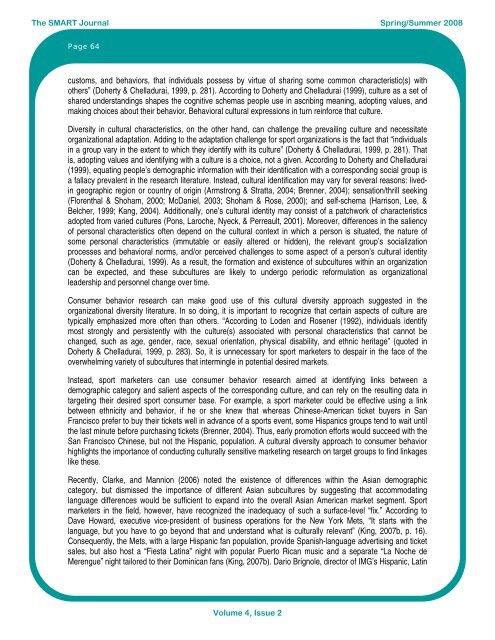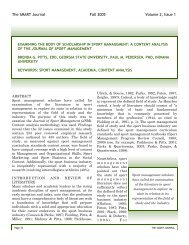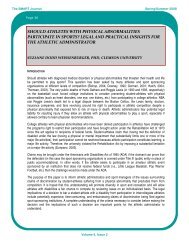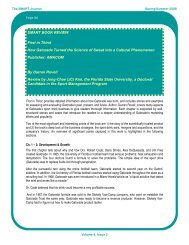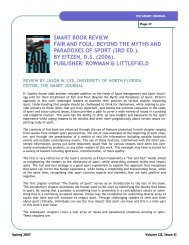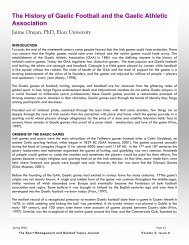Spring/Summer 2008 Volume 4, Issue 2 - The SMART Journal
Spring/Summer 2008 Volume 4, Issue 2 - The SMART Journal
Spring/Summer 2008 Volume 4, Issue 2 - The SMART Journal
You also want an ePaper? Increase the reach of your titles
YUMPU automatically turns print PDFs into web optimized ePapers that Google loves.
<strong>The</strong> <strong>SMART</strong> <strong>Journal</strong> <strong>Spring</strong>/<strong>Summer</strong> <strong>2008</strong><br />
Page 64<br />
customs, and behaviors, that individuals possess by virtue of sharing some common characteristic(s) with<br />
others” (Doherty & Chelladurai, 1999, p. 281). According to Doherty and Chelladurai (1999), culture as a set of<br />
shared understandings shapes the cognitive schemas people use in ascribing meaning, adopting values, and<br />
making choices about their behavior. Behavioral cultural expressions in turn reinforce that culture.<br />
Diversity in cultural characteristics, on the other hand, can challenge the prevailing culture and necessitate<br />
organizational adaptation. Adding to the adaptation challenge for sport organizations is the fact that “individuals<br />
in a group vary in the extent to which they identify with its culture” (Doherty & Chelladurai, 1999, p. 281). That<br />
is, adopting values and identifying with a culture is a choice, not a given. According to Doherty and Chelladurai<br />
(1999), equating people’s demographic information with their identification with a corresponding social group is<br />
a fallacy prevalent in the research literature. Instead, cultural identification may vary for several reasons: livedin<br />
geographic region or country of origin (Armstrong & Stratta, 2004; Brenner, 2004); sensation/thrill seeking<br />
(Florenthal & Shoham, 2000; McDaniel, 2003; Shoham & Rose, 2000); and self-schema (Harrison, Lee, &<br />
Belcher, 1999; Kang, 2004). Additionally, one’s cultural identity may consist of a patchwork of characteristics<br />
adopted from varied cultures (Pons, Laroche, Nyeck, & Perreault, 2001). Moreover, differences in the saliency<br />
of personal characteristics often depend on the cultural context in which a person is situated, the nature of<br />
some personal characteristics (immutable or easily altered or hidden), the relevant group’s socialization<br />
processes and behavioral norms, and/or perceived challenges to some aspect of a person’s cultural identity<br />
(Doherty & Chelladurai, 1999). As a result, the formation and existence of subcultures within an organization<br />
can be expected, and these subcultures are likely to undergo periodic reformulation as organizational<br />
leadership and personnel change over time.<br />
Consumer behavior research can make good use of this cultural diversity approach suggested in the<br />
organizational diversity literature. In so doing, it is important to recognize that certain aspects of culture are<br />
typically emphasized more often than others. “According to Loden and Rosener (1992), individuals identify<br />
most strongly and persistently with the culture(s) associated with personal characteristics that cannot be<br />
changed, such as age, gender, race, sexual orientation, physical disability, and ethnic heritage” (quoted in<br />
Doherty & Chelladurai, 1999, p. 283). So, it is unnecessary for sport marketers to despair in the face of the<br />
overwhelming variety of subcultures that intermingle in potential desired markets.<br />
Instead, sport marketers can use consumer behavior research aimed at identifying links between a<br />
demographic category and salient aspects of the corresponding culture, and can rely on the resulting data in<br />
targeting their desired sport consumer base. For example, a sport marketer could be effective using a link<br />
between ethnicity and behavior, if he or she knew that whereas Chinese-American ticket buyers in San<br />
Francisco prefer to buy their tickets well in advance of a sports event, some Hispanics groups tend to wait until<br />
the last minute before purchasing tickets (Brenner, 2004). Thus, early promotion efforts would succeed with the<br />
San Francisco Chinese, but not the Hispanic, population. A cultural diversity approach to consumer behavior<br />
highlights the importance of conducting culturally sensitive marketing research on target groups to find linkages<br />
like these.<br />
Recently, Clarke, and Mannion (2006) noted the existence of differences within the Asian demographic<br />
category, but dismissed the importance of different Asian subcultures by suggesting that accommodating<br />
language differences would be sufficient to expand into the overall Asian American market segment. Sport<br />
marketers in the field, however, have recognized the inadequacy of such a surface-level “fix.” According to<br />
Dave Howard, executive vice-president of business operations for the New York Mets, “It starts with the<br />
language, but you have to go beyond that and understand what is culturally relevant” (King, 2007b, p. 16).<br />
Consequently, the Mets, with a large Hispanic fan population, provide Spanish-language advertising and ticket<br />
sales, but also host a “Fiesta Latina” night with popular Puerto Rican music and a separate “La Noche de<br />
Merengue” night tailored to their Dominican fans (King, 2007b). Dario Brignole, director of IMG’s Hispanic, Latin<br />
<strong>Volume</strong> 4, <strong>Issue</strong> 2


